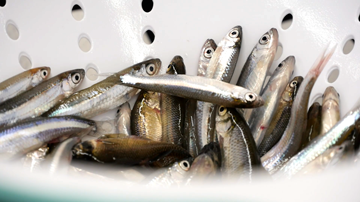A team of researchers at The University of Toledo and the National Oceanic and Atmospheric Administration (NOAA) will host a public education forum to help prevent invasive species from entering the Great Lakes through bait shop retailers and their customers.
The public is invited to a town hall meeting at 8 p.m. Thursday, April 26, at the WGTE Public Media studio, 1270 S. Detroit Ave. in Toledo, to learn more about how non-native species may potentially find their way into the Great Lakes and what can be done to prevent it.

Dr. Carol Stepien, Distinguished University Professor of Ecology and research division leader at the NOAA Pacific Marine Environmental Laboratory in Seattle, second from right, with researchers at UT Lake Erie Center.
The project is led by Dr. Carol Stepien, UT Distinguished University Professor of Ecology and research division leader at the NOAA Pacific Marine Environmental Laboratory in Seattle, who is working with Dr. Kevin Czajkowski, UT professor of geography and planning, and Dr. Andrew Solocha, UT associate professor of finance.
“We found that bait shops sometimes accidentally sell non-native species mixed in with other bait,” Stepien said. “If non-native species such as silver carp become prevalent in the Great Lakes, it is predicted they could decimate valuable native species such as lake trout, walleye and yellow perch. They compete with these native species, depriving them of their food and habitat and can carry pathogens.”
The researchers sampled water from bait tanks for genetic material in 51 bait stores in 2016 and 2017 around Lake Erie. They found that 43 percent of the shops dispensed misidentified species. Using a technique called environmental DNA sampling, researchers sampled genetic material from bait tank water and found DNA evidence of invasive species such as silver carp, round goby, mosquitofish and tadpole snails in several bait shops.

These minnows were in a bowl at the UT Lake Erie Center, where researchers analyzed samples as part of a study to prevent invasive species from entering the Great Lakes through bait shop retailers and their customers.
The researchers also surveyed 217 anglers. Of those, 61 said they fished in Lake Erie.
“From our surveys, we found that 66 percent of Lake Erie anglers use live bait fish, and 50 percent of those reported discarding live bait into the water,” Stepien said. “This coupled with the instances of non-native bait in shops surrounding Lake Erie makes this region at definite risk of introduction of invasive species.”
The goal of the town hall meeting is to discuss the research findings and help the public and bait shop owners understand responsible measures they can take to prevent invasive species from entering the Great Lakes.
“Releasing non-native pets, bait and other organisms into waterways can have unpredictable and widespread effects on Lake Erie’s long-term ecological health,” Stepien said.
The team is also planning a voluntary “invasive free” certification program for retailers.
In addition to Stepien, the panel of experts will include representatives from the Toledo Zoo, Maumee Bait & Tackle, the Lake Erie Charter Boat Association and NOAA’s Great Lakes Environmental Research Laboratory.